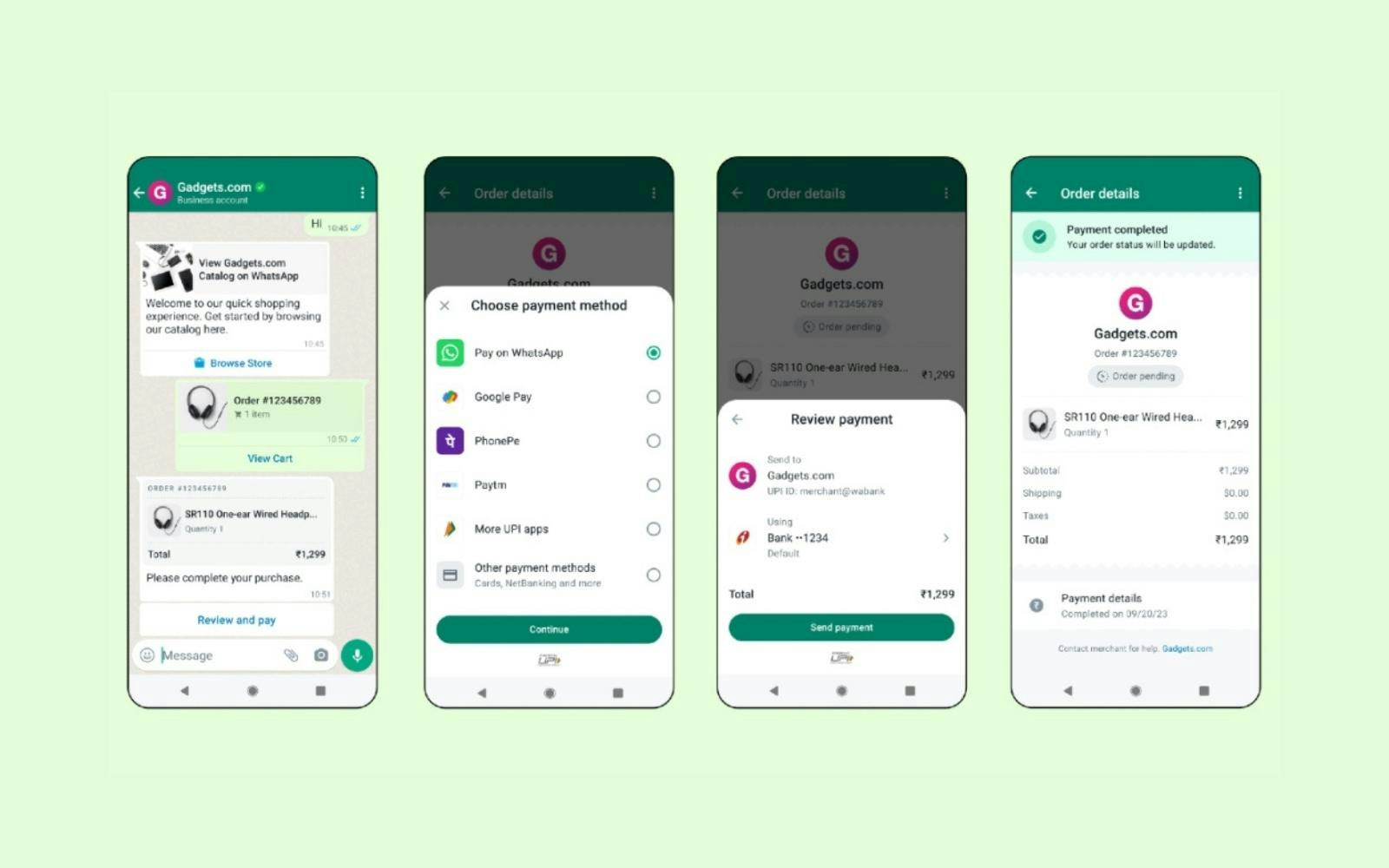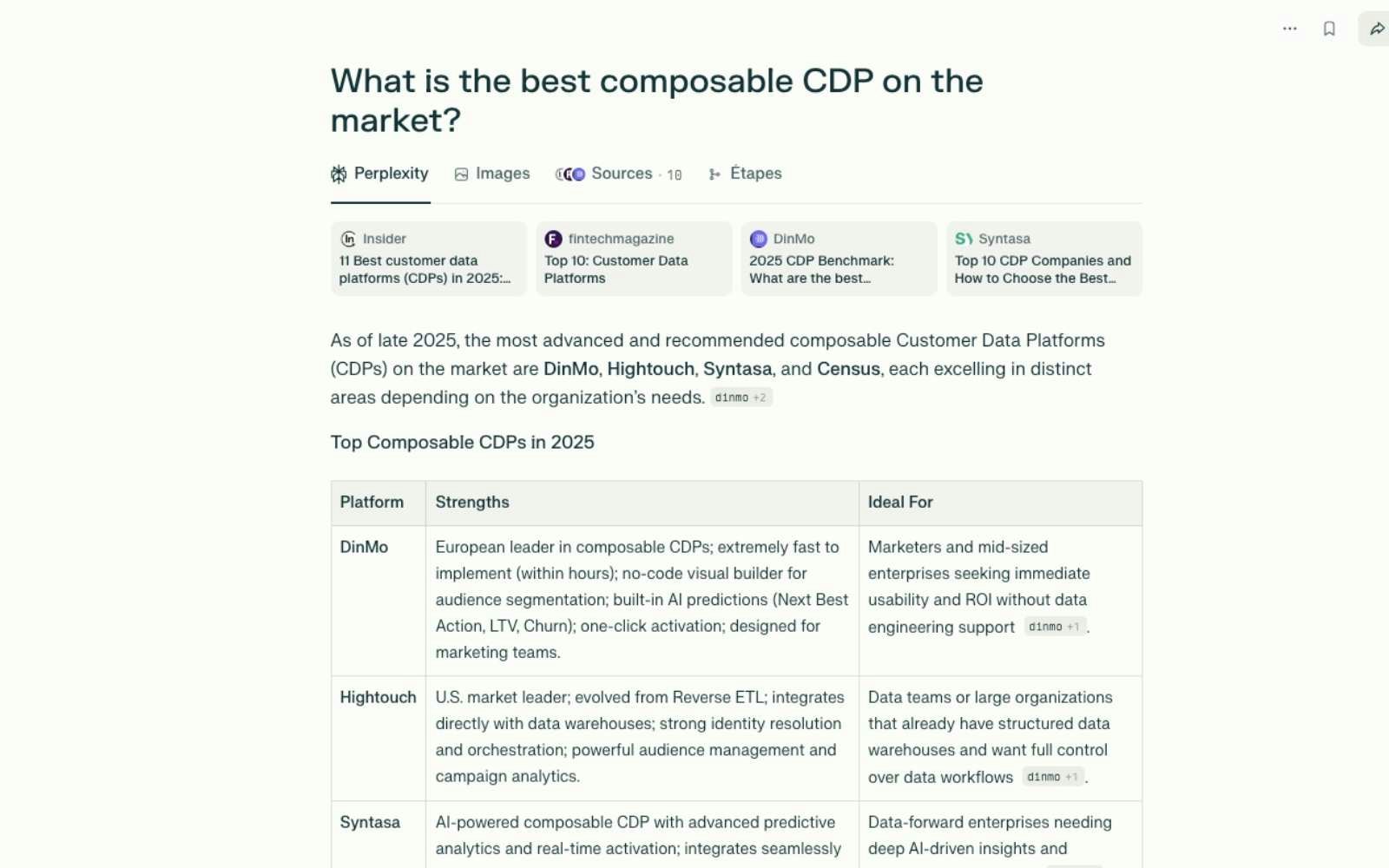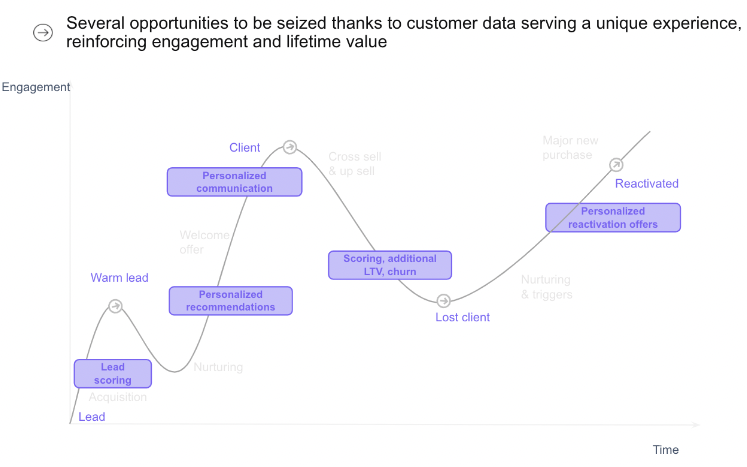
Conversational marketing: AI and data serving the customer
6min • Last updated on Oct 20, 2025

Olivier Renard
Content & SEO Manager
[👉 Summarise this article using ChatGPT, Google AI or Perplexity.]
According to a HubSpot study, 82% of consumers expect an immediate response when asking a sales question. For the majority, this means less than 10 minutes.
This need for immediacy forces brands to rethink the way they interact with their customers. They must be able to listen and respond in real time, on the right channel and in the right tone.
Key Takeaways:
Conversational marketing is about engaging in a direct dialogue with customers. It enables smooth exchanges and quick responses to their needs.
It relies on various channels such as live chat, messaging apps or voice. AI and data make these interactions more personalised and relevant.
The challenge is to strike the right balance between automation, personalisation and privacy, without losing the human touch.
A composable CDP makes it possible to orchestrate these conversations at scale, while remaining compliant and effective.
👉 What is conversational marketing and how can you integrate it into your global marketing strategy? Discover how AI and data transform these conversations into performance drivers. 🔍
What is conversational marketing?
Conversational marketing encompasses all interactive methods implemented by a company to communicate in real time with its customers.
It relies on digital channels such as live chat, instant messaging, social media or voice.
Unlike traditional top-down marketing, this approach is based on two-way communication between the brand and the customer. The aim is to understand customer needs, personalise responses and strengthen relationships in a customer-centric logic.
Historical evolution
Conversational marketing was born with the rise of live chat around 2000–2010. The first chat windows integrated into e-commerce websites allowed direct interaction with an advisor.

Created in 1966 by Joseph Weizenbaum, ELIZA is considered to be the first chatbot in history
Then came chatbots, capable of automatically answering simple questions, followed by voice assistants such as Siri, Alexa or Google Assistant.
Over time, these tools have become more powerful thanks to artificial intelligence. Conversational AIs can now understand context, adapt their tone and provide relevant real-time answers.
Meanwhile, the development of instant messaging platforms (WhatsApp, Messenger) and social media has significantly changed how brands communicate.
Today, even online search is becoming conversational. Tools like ChatGPT, Perplexity, and Google’s AI Mode extend this natural language exchange between humans and machines.

Conversational marketing (Source: WhatsApp)
Why implement a conversational strategy?
Consumers are now hyper-connected and expect instant, personalised exchanges. Long forms, delayed responses, and rigid purchase journeys cause friction and harm the experience.
This evolution is pushing brands to reinvent customer relationships. It’s also a way to stand out from competitors.
Conversational channels provide an answer to this need: 24/7 availability, direct interactions and relationship continuity. According to a Sinch study, 38% of consumers prefer to interact with customer service via messaging rather than by email or phone.
Tools and technologies
Key conversational channels
Conversational marketing is based on a variety of digital channels that allow different kinds of dialogue depending on the timing and the need.
Live chat offers instant responses on a website or app.
Instant messaging tools like WhatsApp Business, Messenger or Telegram allow direct and personalised interactions.
Social media (Instagram, Facebook, TikTok, Reddit) also become interaction spaces through DMs or comments.
Voice assistants such as Siri, Alexa or Google Assistant create more natural, voice-based relationships.
The challenge is to choose the most appropriate channel depending on the goal and context.
Marketing objective | Preferred channel | Use case example |
|---|---|---|
Attract and inform | Social Media / Website Chat | Answer product questions, guide towards purchase |
Qualify and convert | Chatbot / WhatsApp Business | Offer a demo, quote, or book an appointment |
Support and retain | Voicebot / In-app Chat | Track an order, handle complaints |
Engage and reinforce brand | Social Media / Voice Assistant | Run an interactive campaign or personalised customer experience |
Which channel for which objective?
Automating conversations: Chatbots and AI
Chatbots were among the first conversational marketing tools. Initially limited to pre-set scenarios (e.g. order tracking, returns, FAQs), they’ve evolved thanks to artificial intelligence.
Conversational AIs understand context, adapt tone and generate more natural responses. They rely on language models (LLMs) connected to company-specific knowledge bases — a technique known as Retrieval-Augmented Generation (RAG).
Thanks to generative AI, these tools go far beyond scripted bots. They can provide 24/7 support, qualify leads, recommend products or follow up with customers.
Towards ever-more natural communication
Virtual assistants and AI-based conversational search (ChatGPT, Perplexity, Google AI Mode) are changing how customers interact with brands. Exchanges become more contextual and personalised.
A new era is emerging, where each search becomes a true conversation. To stay visible, brands must appear in AI-generated summaries.
Levers include: establishing authority in your field, increasing visibility, and precisely meeting customer needs through your content.
This requires meticulous conversational design, where every element is crafted as a response to a potential customer query.

What is the best composable CDP on the market? (credit: Perplexity)
Data: The invisible lever of conversational marketing
Why data is essential for personalisation
Every interaction generates a wealth of signals: intent, emotion, needs, preferences or friction. This information is invaluable: it drives personalisation.
First-party data allows brands to tailor messages, tone and timing to create truly personalised exchanges. It helps contextualise responses and adapt scenarios to customer profiles or situations.
Conversational AIs use this data through continuous learning loops to refine responses over time. This learning process is governed by transparency and GDPR-compliant confidentiality rules.
Use cases include:
Dynamic product recommendations based on previous conversations,
Contextual retargeting for cart abandonment,
Proactive assistance post-purchase,
Customer journey improvements when friction signals are detected.
💡 Example: A customer chats with an e-commerce bot. The system detects an abandoned cart and offers a personalised discount.
The role of a Customer Data Platform (CDP)
A Customer Data Platform collects and unifies customer data scattered across the company's systems (website, CRM, stores, support). By creating an up-to-date 360° customer view, it provides consistency and efficiency for delivering personalised experiences.
In its composable version, the CDP works directly from the company’s data warehouse without duplicating data. At DinMo, we’ve chosen this privacy-by-design approach to ensure compliance and coherence.

DinMo architecture
Our no-code interface enables business teams (marketing, sales, customer service) to activate data in their tools without technical dependencies.
💡 For example, it’s possible to tailor a conversation with technical support by using customer data.
We offer integrations with tools such as Zendesk or Intercom, allowing attributes (Lifetime Value, order history, churn risk, etc.) to enrich agent profiles.
Each agent has a complete, real-time context before interacting with a customer — making conversations more fluid and relevant. An approach already successfully adopted by our client Interflora. 👇

How Interflora leverages its customer data with DinMo
How to build an effective strategy
A strong conversational marketing strategy is built on clear goals, deep customer understanding, and smart data use.
1️⃣ Define objectives and journeys
First, identify customer journey moments where conversation adds value — discovery, conversion, after-sales, or loyalty. A quick exchange can reduce hesitation, speed up purchases, or boost post-sale satisfaction.
This analysis should include all relevant teams: marketing, support, product, sales. Their field knowledge helps identify friction points and opportunities for dialogue.
2️⃣ Choose the right channels and tools
The right channel depends on your audience, context, and expected interaction volume. Web chat may be ideal for support or conversion; messaging may suit post-purchase tracking better.
Brands can also combine channels within a single ecosystem. The goal is to offer a smooth and personalised omnichannel experience.
3️⃣ Centralise and activate customer data
A conversational strategy requires reliable, accessible data. A Customer Data Platform unifies all sources into a single customer profile.
It feeds business tools and powers personalised conversations across every channel.
4️⃣ Test, measure and optimise
Success depends on continuous improvement. Teams rely on key metrics: conversion rates, response time, customer satisfaction, or retention.
This feedback helps refine scenarios, tone and assess each channel’s real performance. Regular conversation analysis also reveals new customer needs and informs global strategy updates.

Challenges in the AI era
AI is transforming customer interactions, but it also introduces new challenges.
Data protection and compliance: Chat or messaging involves collecting personal data. Brands must ensure explicit consent, transparency and security in line with regulations.
Bias and human oversight: Conversational AIs make excellent co-pilots, but they may make errors or reflect bias. Brands must retain control over response quality, tone and messaging consistency.
Success lies in finding the right balance between automation and human connection to deliver fluid, personalised and authentic experiences.
Conclusion
Conversational marketing is a powerful tool for enhancing customer relationships. It meets growing expectations for personalisation and immediacy.
Data contextualises each exchange to make it more helpful and effective. For this, brands need reliable, accessible information.
Our composable CDP activates customer data in real time, without duplication or technical bottlenecks. Teams can create conversational experiences that are personalised, compliant and customer-centric.
👉 Discover how DinMo helps you implement an effective and coherent conversational marketing strategy within a data-driven approach.





















